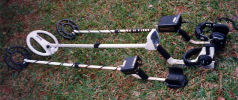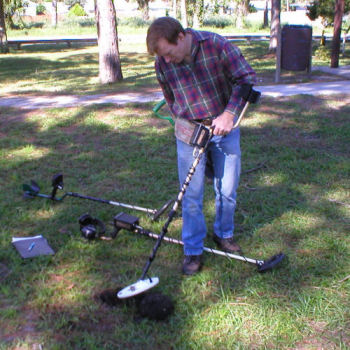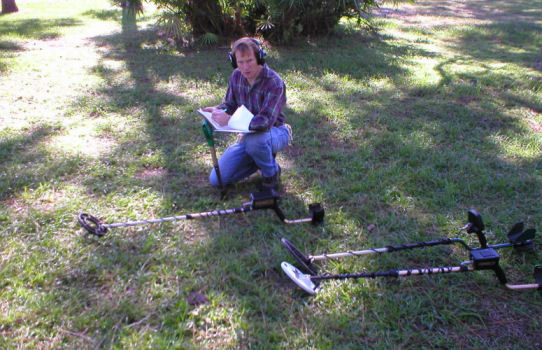Re-printed from NASA Toms website site link
To purchase NASA Tom’s outstanding metal detecting DVD, click HERE
Head-To-Head Comparison Testing
by: Thomas Dankowski
Drafted May, 2006

One person claims 7″ on a dime in one State and another person claims 12″ on a dime in another State. One person hunts a particular site with Brand-X detector, then, the very next day, he hunts the exact place again with Brand-Y detector and finds more good targets, then touts the Brand-X detector as inferior. These are very common and misleading occurrences.
A head-to-head comparison is VERY difficult to perform. Absolutely ALL variables must be removed if any form of validity is to be ascertained. The slightest changing variable can completely void the test. — Let’s get dirty and come away clean.
A textbook perfect test-garden is a good start, yet it does not represent the real world dirt conditions. This includes simplex and complex test-garden scenarios. The preferred method for head-to-head comparison takes place at several different sites with varying mineralization and with several different undug, undisturbed targets in their natural settings.

Let’s say you have selected a local park. You have located several ‘items of interest’ and marked their exact pinpoint location with colored plastic poker chips. You turn off Brand-X detector and swap it out for Brand-Y detector. Here is where the difficulty begins. Was Brand-X detector control panel settings optimized for each individual target? Was the level & quality of signal documented (for comparison) on each individual target….. or are you ONLY seeking to find ‘detectable’ or ‘not detectable’ (go/no-go) scenarios to each detector being tested…… regardless of signal strength/quality? How high was the coil over the target(s)? How fast was the coil sweep speed? Are you aware that one detector may like a fast sweep speed…. and the other unit resolves better with a slower sweep speed? Were you facing the exact same direction when sweeping the coil over subject target? Was Brand-Y detector coil sweeping the subject target one inch further forward or aft of the exact pinpoint location? Was only one of the units properly ground balanced? Is this type of information potentially “interpretive”? Are you slightly biased more favorably towards Brand-X detector? Does Brand-Ex detector come standard with a 10.5″ coil and Brand-Z detector is factory 8″ coil equipped? What is categorized as ‘fair’ or ‘unfair’? When you went back to the car to swap detectors, did the nearby local radio station switch from nighttime 10KW to daytime 50KW transmit power? Or did the A/C compressor and pool pump cycle ‘on’ at the nearby building? Were your steel-toe’d shoes and steel shovel a bit closer to the coil of Brand-X whilst comparing detectors? Is Brand-T detector more resonant on low conductors (nickels) and Brand-Z detector more resonant on high conductors (silver dimes)? Does one brand detector fall flat on its face in bad ground, yet it will trump all other detectors in fairly mineral-free dirt —- and you only gave it one chance at one location —- and came to one final conclusion? Are you trying to compare Brand-T detector equipped with an extremely tight electromagnetic footprint bi-axial elliptical DD coil to Brand-Z detector with a concentric coplanar coil? Are you seeking to find which detector is simply the deepest unit — or which one presents the best enhanced adjacent target separation characteristics? Are you aware that one detector may be superior at finding coins next to pull-tabs (non-ferrous) trash and another detector may be superior at finding those same coins next to nails (ferrous) trash? Is one person operating Brand-X unit and a different person operating Brand-Y unit? Can you see where this might make a difference? Did you know that you can mark targets today — and tomorrow you may or may not be able to detect these exact same targets? If tomorrow brings different humidity, temperature, rain or electrical interference, did you know that a whole new set of parameters exists? Are you aware that one detector may find one set of targets and another detector may find a completely different set of targets in the same field? Does this make one unit inferior/superior to another unit?

This brings up another interesting scenario/phenomenon. Say a [very small nail] is 6″ deep — and a silver dime is directly beneath the nail, one inch deeper — at a total depth of 7″. In your hands, you have one detector and two coils; a 5″ coil and a 10.5″ coil. With the small coil installed, the 6″ deep nail is a moderate signal strength — and the (one inch deeper) 7″ deep dime is starting to “push the depth limits” of the small coil, yet still within detectable range; HOWEVER, the dimes signal strength to the small coil is much weaker than the shallower nail — so the detector reports “iron”. A one inch deeper depth to the small coil is a formidable signal strength reduction. x-x-x-x-x Now you install the large 10.5″ coil. A target at 6″ and a target at 7″ is hardly even a difference to the larger coil — the field intensity at 6″ & 7″ are nearly the same; HOWEVER, the detector reports “coin” because the dime has a larger mass as compared to the [very small nail]. Sometimes this phenomenon is referred to as the “wrap-around” effect. So, is this apples-to-apples… head-to-head comparison? Interpretive it is! In any case, being armed with this knowledge can prove to be VERY fruitful. The same detector with different coils may ‘light up’ completely different targets in the same area. Keep that in mind.
As you can see, there are many things that can alter data resultants. One of the more common mistakes is to be facing, say West (270 deg.) while sweeping with Brand-X, then repeat the same process with Brand-Y detector in almost exactly the same direction, nearly due West (say 255 deg.). This slightly different (15 deg. difference) sweep angle, in many cases, is just enough of a difference to invalidate the comparison. A tight footprint DD coil can highly accentuate this common occurrence as you rotate your body around the target. This is also to say that you may have hunted a parcel of land numerous times, always walking South to North (facing North), yet you keep finding more targets. Maybe a particular target could only be electromagnetically illuminated when the coil is passed over the target from a Northwest-to-Southeast approach angle. One day you are facing (and walking) North again, but, this particular time the target is on your Right side of your sweep (vs. directly in front of you or slightly to the Left side); hence, your coil approach angle into the target is finally the correct angle and – “Bam” you get a good hit. Upon further examination, you decide to rotate your body around this specific target while sweeping — only to discover that this particular target is detectable in a certain window-of-opportunity of body rotation — and is undetectable from other approach angles,,,, possibly due to a co-located trash target in close proximity to the good target. You may or may not be able to hear the culprit trash item, because of masking, silent masking or your level of discrimination dialed in to your detector. (If you have tone ID capabilities, use zero discrimination for the full intelligence package of existing dirt scenarios). Depending upon how your coil approaches into the co-located targets, dictates how the detector will respond.
Find the right tool for the right job. Detectors are akin to eye-glasses. There are spectacles for specific tasks such as; near-sightedness, far-sightedness, high magnification macro viewing, long-range zoom viewing, reading glasses, 3-D viewing, Solar eclipse viewing, low-light/night-vision viewing, Sun shades and shades that are specifically designed for nothing … except to just simply look “cool”. And detectors with ‘flames’ to just simply look ****** ,,,,, you know the rest of the story!

All of this information sounds like ‘data overload’. There are many additional scenarios that can void a head-to-head test. Sounds discouraging and difficult, doesn’t it? The bottom line is; DO YOUR BEST! Remove as many of the variables as possible. If you can have your buddy standing behind you ,,, handing you detectors and equipment,,,, whilst you have your feet planted in the exact same unmovable spot…….. chances are your head-to-head testing should generate valid results — as sweep angle direction, temperature, ground moisture content, humidity, local electromagnetic interference, local ground mineralization content and other potential “variables” become “constants”. When you become accustomed to this procedure,,,,, you will learn that it was not that difficult after all!!! Your conclusive analysis may very well present a resultant that is not in accord with your initial expectations. Keep an open mind and don’t be biased ….and enhanced performance will ensue. Your increased awareness and intelligence will ‘magically’ increase your volume of “keeper” finds!!!
Happy Intelligent Hunting
Thomas Dankowski
